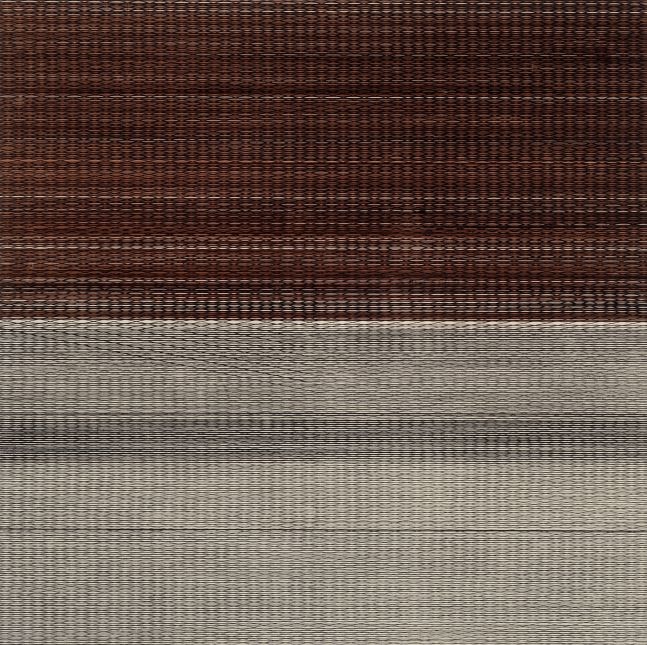
The grid, unplugged, an exhibition of important drawings by Nasreen Mohamedi (1937-1990) resonates the complex relationship between line, place, space and the poetics of discovery that are located in the drawing. How is it that Mohamedi, with her evenly spaced horizontal and vertical lines, has produced a body of work that is so poignant?
Almost all the elements of Mohamedi's inventive repertoire from the 1970s are evident in this ensemble of works: lines in all four directions (vertical. horizontal, left and right diagonal), straight and not straight, touching and not touching, solid and broken, gridded and arced. Her meticulously rendered pen and ink drawings show precision in execution, where the line spacing varies from picture to picture. In some, the lines are equidistant, like rules on notebook paper. In others, the pattern is more complicated, even intricate, like formal rhyme schemes in poetry, with lines alternating, single lines or unlined spaces.
Few artists have developed their investigation in a manner that is as complex and subtle; she articulates geometry, perspective and the grid; architecture and design to track the unchartered possibilities of abstraction. Her concerns were diverse, ranging from landscape and architecture to the subtle delights of salt bubbles in the sea, lines in the sand, painted road crossings, shadows of objects and textile looms (as seen in her photo-based works).
Both in drawing and photography, the use of line in Mohamedi's work create grids, patterns. and diagrams of varying tonality. She utilizes media such as pencil, ink, and pen, as well as a variety of linear directives including: straight; even and uneven; touching and not touching; random and ordered to give form to the idea. The result is an extraordinary confluence of works, variously bold and subtle, improvised and predetermined, clear and cryptic, reductive and expansive. For all their diversity and complexity, they are nonetheless informed by a singular aesthetic that Mohamedi formulated in the 1970s.
Her work lends itself to drawing as a means towards creating an active line - a line/ lines that are improvisatory and always in motion, in the sense that it proceeds without closure or completion - continually part of a process that is never-ending. From a distance they seem to palpitate, as half-visible linear patterns come in and out of focus. Up close the same pictures can look both diagrammatic and eventful, even suspenseful, as you register slightly different weights in drawn lines or modulations in the pen and ink application that suggest a more "scientific" approach to her art, one that focuses on her drawings' formal, optical properties.
Mohamedi's drawings emphasize in abstract form the relationship between drawing and thought or idea, as she weaves abstract fields from tracks of tiny crosses or marks, exploring through abstraction the conflation of inside and outside, micro and macro, thought and action, in her intricate drawings. She does this through a highly selective process of inclusion and exclusion, intertwining planes and grids and reducing them to skeletal patterns of horizontal, vertical and diagonal lines. She writes in her diaries of the need to take from an outer environment and bring it an inner necessity ... " Her drawings are about weightlessness, about merging and about breaking down of "form" which enables the creation of a field of vision with all its intricacies - intricacies that make us conscious of the intimate relationship between abstraction and aesthetics, between the conceptual and the formal.
Indeed, Nasreen's quiet, graceful oeuvre is a deliberate counterpoint to the increasingly aggressive and intrusive nature of images and technology in our everyday lives. Her practice is a testament to the value of "concentration" and "precision", both in the repetitive gestures that create her subtle compositions and in the enhanced awareness they call forth from the viewer. The surfaces not only demand extended viewing, but also actually respond to the act of looking; slowly scanning the drawings causes one's eyes to adapt to the graduated contrast, which in turn causes the peripheral use of lines to shift. More than anything, Mohamedi's works on paper narrow and focus the eye's attention. You have to stand close to them. You have to "read" every line. They demand intimacy and a kind of commitment. But what they give back, in their simplicity and richness, is indescribably moving.
In conclusion, Mohamedi's drawing offers us the most extraordinary range of possibilities: it is a map of time recording the actions of the maker. It is, as Michael Newman writes, a record of "lived temporality'' and in the sense that a drawing is by essence always incomplete. A line always suggests a continuation ad infinitum and thus connects us with infinity and eternity. Her drawings enjoy a direct link with thought and with an idea itself. Its very nature is stable, balanced equally between pure abstraction; its virtue is its fluidity. Her drawings are highly controlled and delicate, an act of homage, redolent of personal memory, history or desire ...
Mohamedi's drawings in this exhibition challenge us to reassess the commonly held assumptions of what constitutes a picture/ an image, helping us acquire a deeper understanding of the extraordinarily diverse and widespread uses of 'drawing' in the art world today.
-Sasha Altaf